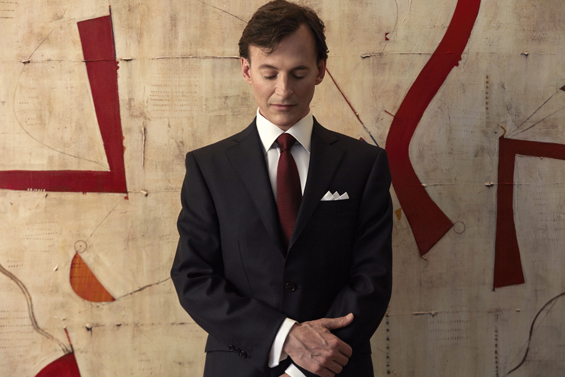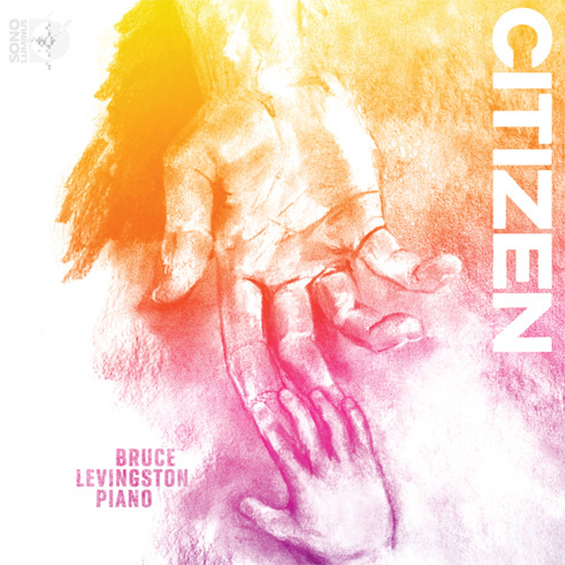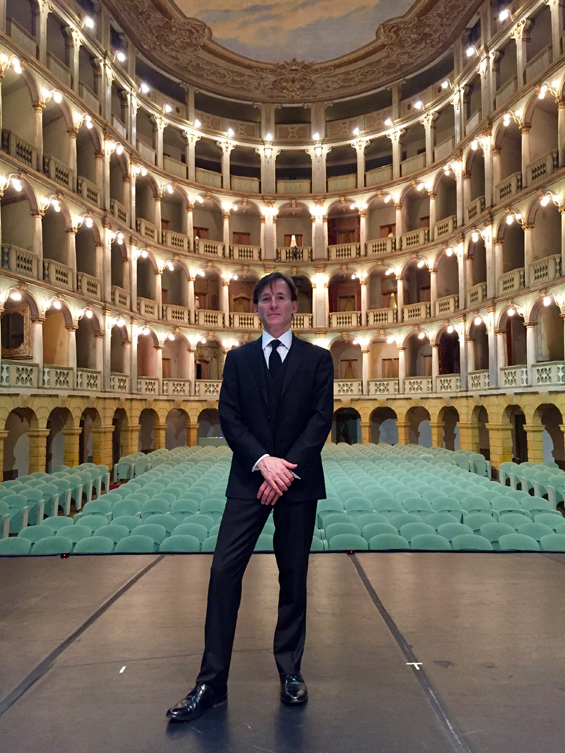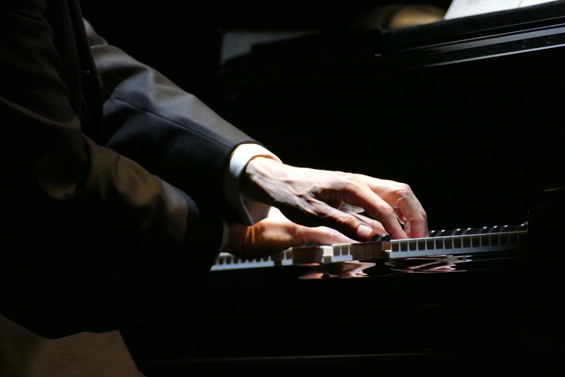

(photo: Tony Notarberardino)
TEN QUESTIONS WITH BRUCE LEVINGSTON
textura has had the great pleasure of reviewing many releases by American concert pianist Bruce Levingston, from Dreaming Awake, his two-volume set of Philip Glass material, to his most recent, 2019's Citizen, and now has the even greater pleasure of featuring him in an interview capacity. By any standard, his career has been remarkable, the acclaim he's received fulsome and the accomplishments many. In addition to performing on some of the greatest stages, Carnegie Hall, Lincoln Center, and the Royal Opera House at Covent Garden among them, he's been a leading promoter of contemporary classical music: his personally founded music foundation, Premiere Commission, Inc., has been instrumental in the commissioning and premiering of over sixty works, and his recordings regularly couple performances of new compositions with ones by Chopin, Schumann, Brahms, and Bach. Common to all Levingston releases is his masterful piano playing, every performance illuminated by his deep engagement with the material and sensitivity of touch. The interview transpired during a time when lives are being profoundly affected by COVID-19 and race-related issues, and that's naturally reflected in some of what follows.
1. First, how you are faring? If I'm not mistaken, you live in New York City and so have been dealing with some of the most extreme pandemic-related circumstances. In what ways has it affected your personal and professional lives, psyche, and creative energy?
Throughout the last decade, I've balanced my time between New York City and Oxford, Mississippi. I am fortunate to hold the Fant Chair in the Honours College of the University of Mississippi. When the pandemic hit, I postponed upcoming performances and decided to remain in Oxford. One highlight of my last few months has been zoom conversations with my talented students. In my course “Art and the Republic,” we focus on nuances in society and practice hearing and discussing different points of view with empathy and civility.
Students aren't the only ones staying engaged: one touching moment occurred when an old high school classmate sent me an unexpected email. An oncologist, he found himself on the front lines treating Covid patients. He and his colleagues recognized the challenge of this terrible period, and he wanted to create something constructive from it. He'd read that I commission new music and offered to support the creation of new work to memorialize this time. I had already been working to support composers hurt by this period through small grants. But through his generosity, I was able to reach out to a few more composers and commission some fine new works. Amidst the sadness and loss caused by the virus, one must be grateful to connect (and re-connect) with such caring people.
2. As you're a native of the Mississippi Delta, I'm curious about when you moved to NYC and whether there was some degree of culture shock when you did. And, just to get a clearer sense of who you are, what might a typical day-in-the-life be like for Bruce Levingston?
I had been to New York a few times before I finally moved there. It was a place I immediately loved and one for which I felt an instinctive affinity. The swirl of creative figures and cultural institutions was exhilarating. By sheer good fortune, I was seated next to Kurt Vonnegut, one of my favourite writers, at the first dinner party I attended! In succeeding years, I was able to hear many inspiring artists perform, including Pavarotti, Rostropovich, Norman, Horowitz, Fischer, Arrau, de Larrocha, Serkin, Kremer, Argerich, and others. One of my many interesting neighbours at the Chelsea Hotel was Virgil Thomson, who was always very kind to me. What makes New York so special is that remarkable mix of people and creative energy.
As for a typical day, right now I'm submerged in Bach and Brahms. I practice several hours a day learning new scores and re-learning old ones, teach and mentor current and former students, read various newspapers and books, try to maintain cardio on the treadmill, and, when not walking in them, try to keep my shoes away from my dogs!
3. The material on your 2019 Sono Luminus release Citizen deals deeply with race, inequality, and human rights, issues that have been and remain still central parts of American experience. What compelled you to confront such issues on the release and what did you hope to achieve in doing so?
I spent the first fourteen years of my life in Mississippi. My family has lived there for generations, and it is a place I love deeply. But it is also a complex state. While it has produced some of the most important artists in music and literature our country has known, it has a painful and sad racial history. Three works on Citizen respond to this, and two are pieces I commissioned in honour of the 2017 opening of the Mississippi Civil Rights Museum. The opening of that museum was an extraordinarily significant event for Mississippi, which has witnessed much tragedy for African-Americans, including the murder of civil rights leader Medgar Evers. At the museum's opening, I had the opportunity to meet and speak with his widow, Mrs. Myrlie Evers-Williams. It was one of the most moving encounters of my life. In the midst of brutality, cruelty and silence, she persevered to attain justice for her slain husband. She exudes hope, courage, and kindness and is a model of humanity.
The third piece, a work by Nolan Gasser called American Citizen, was inspired by Marie Hull's painting of the same title. The subject of the painting is a former slave named John Wesley Washington. Hull's title proclaims Washington's equality as a citizen of our country. That was in 1936.
I write these words in the wake of the senseless, horrific death of George Floyd, and others. There is a moral imperative to say something. To do something. To speak up. I lost members of my own family in the Holocaust, and believe that period happened because many people did not speak up. These are matters of basic human rights, decency, and freedom.

4. It seems as if there has never been more divisiveness than today, whether we're speaking of the conflicts between people within one country or between countries. Is it possible to see music and yourself as an artist as a means by which bridges can be forged between different people and communities?
I think it first begins with us as individuals, even before one's art. Being kind to one another, and listening to one another with respect is a start. When fellow citizens are hurting, we should listen, and do something.
As an artist, I think our choices can create positive change. Inspired by the opening of our Civil Rights Museum, my album Citizen is a direct artistic plea for societal change. One of the works on the album, Summerland, was written by William Grant Still, a composer born in Mississippi in 1895.
He was the first African-American composer to have a large work performed by a major symphony orchestra. Written in 1934, Summerland was the composer's vision of a land without racism. He wrote Summerland in G-flat major. His daughter told me that when he submitted the score, a publisher told her father that “black composers shouldn't be writing music in such complicated keys.” The publisher then insisted that Summerland be printed in G major. When I performed the work in Carnegie Hall in 2018 and later recorded it, I played it in its correct original key.
5. I'm imagining you might currently be preparing a follow-up to Citizen. If so, could you say a few words about it and when it might arrive?
Yes. I'm working on a new album that I'll record in the coming months. The music takes listeners on a journey across four centuries of music, exploring the spirit of inner solitude. Bach figures prominently throughout. His music touches every level of the human experience. Since childhood, I've been enthralled by his endless capacity to reach the soul. There is also the haunting music of late Brahms, which evokes that delicate twilight between life and death. Such music feels very appropriate for this fragile time in our world.
6. When you reach the level of virtuosity that you have, are technical challenges no longer an issue, or are there still things you work on?
Virtuosity is sometimes thought of as the ability to play with accuracy, velocity and bravura, and those are certainly important elements. I still practice scales every day in all keys, and in thirds, sixths and octaves! But technique is much more than that. At its zenith, it offers a means of producing sounds and colours that can reveal music's inner life and spirit. This requires careful attention to voicing, pedaling, articulation, and nuance. Personality and temperament, though necessary, are not enough. What lights the music up is close attention to the score's architecture, its inner harmonies, counterpoint, rhythms, and phrasing. All these elements must be brought out in a completely natural, musical way, which is physically, technically, and mentally so exacting. And it all should seem effortless! I recently read where Landowska once wrote in a note: “How many days and nights of unrelenting work, of deprivation, of indescribable efforts to succeed in playing with insouciance, with careless ease.”

At Teatro Fraschini di Pavia (photo: H. Cornejo)
7. When you select a piece to perform, do you purposefully avoid other pianists' interpretations? Is your approach to a particular piece something that crystallizes gradually as you perform it over and over, or do you already have a concept in mind beforehand about how you think the piece should be presented?
Many first encounters of the traditional literature occur from hearing other artists, either live or through video and recordings. This is often inspiring, but a performer must be careful not become too locked onto a single interpretation. Even—perhaps especially—when a piece has been played ‘definitively' by a Schnabel, Gould, or Horowitz, one must look at the score as if it were composed just yesterday. As a regular commissioner of new music, I often am playing works that were composed just yesterday! But with previously established works, I try to avoid hearing other interpretations, at least until I have formed my own conception. After that, I might check in to hear how other artists handle a particular passage or get a general idea of their overall interpretation. Ultimately, each artist must make their own choices and be true to their own unique, authentic voice.
8. Speaking of which, who would show up on a list of your own favourite pianists? And are there certain piano recordings that also are favourites and that particularly inspired you?
There are so many different and fascinating pianists with different styles and sounds! I often love to hear people who approach music in a completely different way than I would. However, I definitely have my kindred spirits. Here are a few favourites: Clara Haskil (a completely natural musician); Alfred Cortot (a magician with form and colour); Rudolf Serkin (great depth of expression coupled with sheer fearlessness); Vladimir Horowitz (endless colours and a kind of divine madness); Annie Fischer (exquisite humanity); Radu Lupu (subtlety, nuance, depth); and Michelangeli (magisterial control and sound).
9. In addition to being a pianist, you're also a wonderful writer. The notes you've written that accompany the musical selections on the releases are consistently illuminating, and you're also the author of Bright Fields: The Mastery of Marie Hull. What drew you to want to write about this Southern painter, and might we see another book from you in the future?
You are kind to mention my writing. When I was young, my brother gave me the Journal of Eugene Delacroix. His writing on art and artists of his time, including Chopin, fascinated me and influenced my writing. During those same early years, I came to know Marie Hull's work. Like Delacroix, Hull was a master colourist and also a musician who described her work as “lyrical”. I am fascinated by colours in sound because of all those paintings I saw as a child. My next book may explore the interplay of colour and sound in more detail.
10. You've worked with musical artists such as Brooklyn Rider, Christopher Tignor, and Philip Glass but also figures associated with other arts, including painter Chuck Close, actor Ethan Hawke, and dancers Alessandra Ferri and Herman Cornejo. How important have collaborations with musical and non-musical artists been to your artistic practice? I'm presuming Glass is a favourite composer of yours, given that your double-CD set Dreaming Awake is wholly dedicated to pieces by him and his works appear on your other releases, too. What is it about Glass's music that attracts you so much, and who else would make your short-list of favourite composers?
Art is the means to see, hear, and feel what is in our souls. Beneath the notes and tones, all the different genres are connected and continually influence each other. Often, artists are simply choosing a language or form to express their vision. Schönberg and Mendelssohn were both superb painters. And Berlioz and Schumann were exceptional writers. I have been fortunate to meet many different types of artists and even luckier to collaborate with some of them. They have taught me so much about expression and how to live as an artist. I remember encountering the choreographer Jerome Robbins outside of the Brooklyn Academy of Music. We were both attending a performance of Lully's Atys with Les Arts Florissants. Robbins told me that he had attended every performance and particularly wished to study how the dancers reflected Lully's exquisite ornamentation by “trilling” with their feet. Robbins, seventy at the time, was still learning.
I met Philip in 2003. He had changed the course of music by then and has changed it more since. And not just ‘classical' music; like Picasso, his style evolves. People first heard his music and said, “Oh, that's minimalism.” But his scores reveal a certain evolution. His late period "Etude No. 20," for example, is almost Brahmsian. Both composers share an underlying humanity that touches the soul. I've also been fortunate to play works by many other living composers I admire such as Timo Andres, Lisa Bielawa, Nolan Gasser, Augusta Gross, David T. Little, Wolfgang Rihm, Kaija Sarriaho, Chris Tignor, and Price Walden.

Performing at the Royal Opera House, Covent Garden (photo courtesy of the artist)
Bonus: Some performers thrive on the adrenaline rush of live performance; others regard the scenario with trepidation. As someone who's performed at Carnegie Hall, Lincoln Center, and on other renowned stages, what's your own experience like? Are you unnerved by the prospect of performing alone in front of a large audience or thrilled by it? And is there a performance you've given that particularly stands out, and is there one or two of which you're most proud?
I think all good performances require some nerves. The right amount of edge can take everything to another level. It's the same with halls. Playing in Carnegie Hall where Mahler, Rachmaninoff, and Tchaikovsky performed, or at Covent Garden where Handel conducted, can be daunting or inspiring. I find them to be the latter, and the charge of live performances in them exhilarating.
It is difficult to only pick one. The night I performed the finale of Einstein on the Beach at Lincoln Center with Glass seated at the keyboard alongside me was pretty special. And so was performing at the Royal Opera House with Herman Cornejo and Alessandra Ferri! There have been so many wonderful and unusual concerts in my life.
If I had to pick a single solo concert, it would be the Spring 2002 concert at Lincoln Center. I'd just come through an important period in my life where I had rethought my sound, my music, and myself. The program was fierce and included late Brahms, Webern's Variations, Schubert's Wanderer Fantasy, Debussy Etudes, and Liszt's Mephisto Waltz. A fellow pianist turned to a friend there and said, “If I had to play this program, I'd be throwing up backstage!” Of course, I was challenging myself. Just before I was to walk out to play, a phone rang at the stage door. It was the box office calling: one of the senior critics from The New York Times was in the lobby, and a ticket couldn't be found for him—not news one wants to hear at that moment! Fortunately, a good friend gave up his own seat. Problem solved. Then, as I gathered my composure, I thought, “Oh goodness, the critic from The New York Times is sitting right up front! Be careful.” Then, a split second later, I thought, “No. If I play this careful, I'll never play it at all.”
So I walked out and played with all the passion, intensity, and concentration I could muster. The audience cheered, I received a lovely review in the Times, and embarked on an intrepid, thrilling new journey in my life.
website: BRUCE LEVINGSTON
June 2020![]()